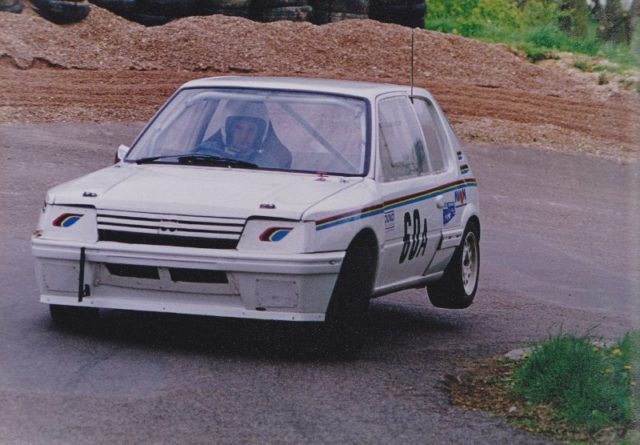Though it might not look like much, this particular Peugeot spent much of its life as a test bed for Benetton Formula 1 team in the early nineties—back when Michael Schumacher drove for them. Willem Toet, who at the time worked as an aerodynamicist for Sauber F1, converted the car to left hand drive for improved weight distribution, and implemented a slew of advanced technologies, like traction control, launch control, and variable length intake trumpets, to take advantage of all the 280 horsepower on tap.
It might only have a four-cylinder motor, but it’s a very racy motor indeed. In fact, the engine heater says it all. Perhaps one of the more interesting engine features are the variable length trumpets. This is the only known Peugeot 205 GTI running this sort of system, which uses a compressed air kevlar cylinder mounted in the engine bay. This is fed to the electronic actuators that direct air to each ram. It’s run by the data logging ECU built by the previous owner and adjusts the length of the throttle body trumpets to gain maximum power and torque at different RPMs! Therefore, though it makes peak power at 8,200 rpm, it enjoys a broad powerband and sufficient grunt to leave a hillclimb’s hairpins swiftly and deftly.
That variable length trumpet system is complemented by custom cams, a dry sump, ported and polished heads, to provide that searing top end, and a quick-shifting gearbox to keep the revs right in the sweet spot. The motor might not generate astounding levels of torque, but as this Peugeot weighs a meager 1,366 pounds, it’s more than enough to hurtle down the road at a frightening pace.

Photo credit: Jeda Motorsport
Like everything else with this finely-tuned backroad scalpel, its gearbox is optimized to waste as little time as possible, but this time, the modifications are very cost-effective. The Peugeot BE1 Box, originally a five-speed, lost its top gear for weight reduction, yet it can still reach 100+ miles an hour. Additionally, it is fitted with a Satchell Engineering shifter for minimizing shift times. Although it’s still a traditional h-pattern gearbox, it requires very little effort on the driver’s end and offers rifle-bolt action for easily repeatable shifts over bumpy surfaces.
https://
Crucially, it makes good use of every horsepower with clever technology. With the help of Richard Marshall, who then worked on electronics for Benetton twenty-five years ago, Toet was able to apply every single one of the 280 horses to the road without the slightest suggestion of wheelspin with their the custom traction control system. In this Peugeot, the system was tested and refined car prior to its later implementation in the Benetton B193 Formula 1 car, with which Schumacher achieved eight podiums and one win during the ’93 season.

Toet used this car as a test bed for a few devices back then—note the pitot tube exiting the passenger window.
Not only was this machine used to develop the traction control which helped the Benetton remain so competitive, but it also served as a test bed for Schumacher’s infamous speed displays, as well as the active suspension; note the pitot tube—the element which made active suspension work—hanging out of the passenger window.
It might look minuscule and harmless, but with the plethora of high-end tech onboard, this little Peugeot went on to dominate British hillclimbs for the rest of the decade, and still remains competitive to this day.





















